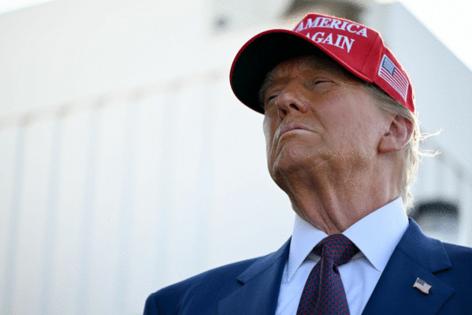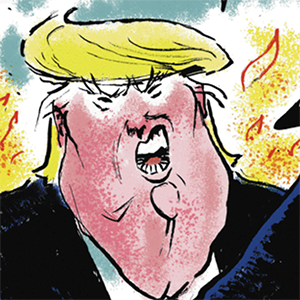Trump and recess appointments: A procedural and legal quagmire
Published in Political News
WASHINGTON — With some of President-elect Donald Trump’s Cabinet and other presumptive nominees facing an uncertain path to confirmation, some Republicans have considered embracing recess appointments to allow Trump to temporarily fill vacancies without Senate approval. But that approach might come with its own complications.
Many GOP senators have hesitated to cede authority over confirmations. With 53 Republican seats, nominees that can’t get majority support shouldn’t proceed, they argue. Former Florida GOP Rep. Matt Gaetz’s withdrawal as Trump’s selection for attorney general, then, would be an example of how the system should work.
Other senators have said that if the Democratic minority next year uses delay tactics — of the sort Republicans themselves employed regarding President Joe Biden’s judicial nominees before the Thanksgiving break, for example — Republicans will be more willing to allow recess appointments.
“If we in the Senate do our job correctly, we won’t need to worry about a recess appointment,” Sen. John Kennedy, R-La., said. “Now, if my Democratic colleagues don’t cooperate, then the issue of a recess appointment may be pertinent.”
One less-likely scenario is that Trump proceeds with recess appointments by using an extraordinary and never-before-used constitutional power to force a Senate recess.
Nonetheless, any actions taken by those recess appointees could be challenged in court and potentially brought to a stop. There are signs that even the conservative-dominated Supreme Court, with three Trump appointees, would find those moves to be unconstitutional.
How recess appointments work
The Constitution permits the president to circumvent the confirmation process for vacancies that “happen” during “the Recess of the Senate.” If appointed during a recess, officials could potentially serve until the end of the next session, or in this case, through the end of the 119th Congress.
The Congressional Research Service has identified 139 recess appointments made by President Bill Clinton, 171 made by President George W. Bush and 32 made by President Barack Obama. Neither Trump in his first term nor President Joe Biden made any recess appointments.
Although not unanimous, there is some sympathy for the recess appointment argument among Senate Republicans. Sen. Thom Tillis, R-N.C., offered qualified support, arguing that there’s plenty of recent precedent.
“I hope President Trump does at least 33 recess appointments. … Because Obama did 32. So if anybody thinks that recess appointments are something new and different, you need to kind of study just a couple of administrations back,” Tillis told reporters.
But he said recess appointments should be off-limits for Cabinet-level positions.
“That should be absolutely off the table,” Tillis said. “These positions are too important and carry too much weight internationally to take a shortcut.”
Supreme Court ruling
Recess appointments declined under Obama because the Senate began staying in session year-round by convening in brief “pro forma” sessions every three days during break periods, such as the chamber’s summer recess. In 2014, the Supreme Court ruled in National Labor Relations Board v. Noel Canning that the Constitution allows the president to fill any existing vacancy, but only if the Senate has been in recess for at least 10 days.
Under the 2014 ruling, the Senate can choose to allow the president to make recess appointments by agreeing with the House to adjourn for at least 10 days.
The court’s decision also left open the possibility for the president to make appointments by forcing a Senate recess. That plan, in theory, would exploit Article 2, Section 3, of the Constitution that allows the president to adjourn Congress “to such Time as he shall think proper” when the two chambers are unable to agree on a time for adjournment.
Ed Whelan, an attorney and senior fellow for the Ethics and Public Policy Center, recently explained in National Review how such a scenario could play out.
First, the House can adopt a concurrent resolution providing for adjournment of both the House and the Senate for at least 10 days, Whelan wrote. The resolution would not be debatable in the Senate and could be adopted by a majority vote, though opposing senators could attempt to filibuster with amendments and procedural motions.
Then, the Senate could choose to adopt the resolution, which would allow time for Trump to make appointments. Or it could reject the resolution, which could allow Trump to assert his constitutional power to adjourn Congress when a “disagreement” exists with respect to the time of adjournment. With the Senate gone for at least 10 days, the president could then begin filling vacancies.
Nuclear option
Of course, it’s no sure thing the House would even act to adopt a recess resolution. In comments to reporters before Thanksgiving, Speaker Mike Johnson, R-La., appeared to defer to Senate prerogatives when it comes to presidential nominees, pointing out that “the Senate has advice and consent responsibility under the Constitution. They have to vet candidates, of course, and they will.”’
And with House Republicans expected to hold a razor-thin majority, it’s unclear whether such a resolution could receive enough votes for adoption, even if supported by GOP leadership.
Additionally, if the Senate simply rejects or declines to act on a House-originated adjournment resolution, that might not constitute a “disagreement” that Trump could exploit, according to Whelan and other experts.
Andy Craig, an adjunct scholar at the libertarian-leaning Cato Institute, wrote that the House and Senate would have to adopt conflicting adjournment resolutions that specify different dates before the president can step in to adjourn them. Simply rejecting the resolution, or refusing to consider it, wouldn’t be enough to trigger the president’s adjournment power, he wrote.
James Wallner of the center-right R Street Institute expressed a similar sentiment in a recent social media post, arguing the Senate “can’t have an opinion until it takes action to have one — to disagree.”
But with Trump and his own attorneys constantly looking for novel interpretations of executive authority, it’s possible they take the position that a disagreement has occurred anyway.
The effectiveness of any recess appointees would almost immediately be cast into doubt, however, as the move could trigger a slew of litigation against agencies led by recess-appointed officials.
It could take some time to work its way through the courts, according to Stanford law professor Anne Joseph O’Connell, who said each recess appointee would need to be challenged by a separate plaintiff with standing.
“The Supreme Court could then consolidate cases or accept one case and hold the others to be remanded to consider the decision in the case they hear,” she said.
Conservative pushback
Litigation regarding any potential Trump recess appointees could set the stage for the Supreme Court to invalidate them by taking a more restrictive stance than it did in its 2014 ruling.
That case involved an instance of presidential overreach, the court found, when Obama made three recess appointments to the NLRB after concluding that the Senate was unavailable to consider nominations, even though it had convened periodically for pro forma sessions.
The Supreme Court unanimously ruled that the appointments were invalid, and a majority, which included the liberal justices and swing-justice Anthony Kennedy, held that the Senate must be in recess for at least 10 days before the president can make a recess appointment.
But the conservative justices strongly disagreed with the majority’s understanding of the Recess Appointments Clause and took a position that Senate Republicans had urged them to adopt.
In an amicus brief, the entire Senate Republican Conference during the 113th Congress urged the court to severely curtail the recess appointment power. Among those who signed the brief, 21 are still currently serving in the Senate.
Republicans called on the court to hold that the “recess” defined in the Constitution means only the recess that occurs after the Senate ends its regular annual session, and excludes an “intra-session” adjournment, which occurs when the Senate temporarily takes a break during its annual session for various reasons, like a holiday or district work period.
They also urged the justices to rule that the president may only fill positions that become vacant during that narrowly defined recess.
Obama’s recess appointments, the senators wrote, “cannot be justified by the Recess Appointments Clause without distorting that provision’s text and purpose beyond recognition: The appointments were made neither during ‘the Recess of the Senate,’ but instead in an intrasession adjournment, nor to fill ‘vacancies that … happene[ed] during the Recess,’ but to preexisting openings.”
Additionally, the senators suggested that the Supreme Court should conclude “that the President cannot unilaterally declare the Senate in ‘Recess’ against its will,” as Obama did by refusing to recognize its pro forma sessions.
Aligning with Senate Republicans, Justice Antonin Scalia wrote a concurring opinion arguing recess appointment power should allow only appointments during the break between the Senate’s formal annual sessions, and only for vacancies that came into existence during that intermission.
Three conservatives currently on the court, Chief Justice John G. Roberts Jr. and Justices Clarence Thomas and Samuel A. Alito Jr., joined the late justice’s opinion.
Because an attempt by Trump to fill positions with recess appointments would likely occur during the Senate’s regular session and would involve positions that did not become vacant during the recess between annual sessions, the Supreme Court’s current conservative majority might rule that such appointments are unconstitutional.
Whelan predicts that the three conservative justices appointed by Trump during his first term — Neil M. Gorsuch, Brett M. Kavanaugh and Amy Coney Barrett — would also be skeptical of a broad recess appointment power that allows intrasession appointments and appointments to preexisting vacancies.
“It’s a very safe bet that Justice Gorsuch, Justice Kavanaugh, and Justice Barrett would agree with Scalia if they were looking at the issues afresh. So that would make a six-justice majority among the current members of the Court,” Whelan wrote.
©2024 CQ-Roll Call, Inc., All Rights Reserved. Visit cqrollcall.com. Distributed by Tribune Content Agency, LLC.




























































Comments